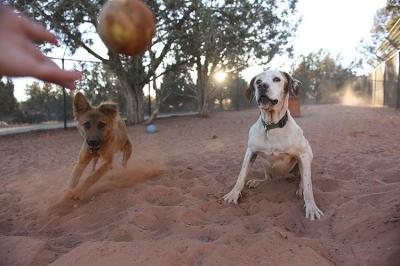
Building Confidence in Dogs
Do you have a dog who seems shy, insecure, or fearful about certain things? Nervousness in dogs can manifest in different ways. Some dogs lunge and bark at whatever is frightening them, some hunker down and freeze until the scary thing goes away, and others give more subtle signs of discomfort. If you become familiar with your dog’s body language, you’ll know when they're stressed. And then you can take steps for building confidence in dogs.
Puppy socialization window
There are lots of reasons a dog might lack confidence and be fearful about navigating their environment. They might have had a bad experience or even have a genetic predisposition toward being fearful or shy.
In many cases, though, the dog simply was not well socialized as a puppy. What this means is that during the critical socialization period (between 3 and 14 weeks old), the puppy was not exposed to enough novel experiences or might have had scary or overwhelming exposure to our human world. During the socialization period, puppies are learning what is safe and unsafe — which plays a big part in shaping who they will become as adults.
Once the socialization window closes, the particular way that learning happens during that period also ends. It doesn’t mean, however, that dogs stop learning. In fact, they continue to learn throughout their lives. And we can help our dogs feel better about things they find frightening — whether it’s new people, places, dogs, sounds, or movements.
How to build confidence in dogs
One way to help a dog feel more confident is to use repeated exposure to the scary thing (the stimulus) so that it becomes less novel and more routine; this is called desensitization. You must be careful, though, not to overwhelm the dog (aka flooding) because this can create insecurity or fear of a person, place, or thing.
Home starts with you
Let’s look at some examples. If you want to get your dog comfortable with, say, going to a popular park, first bring them to a quiet corner of the park and allow them to see and hear other people and dogs from a safe distance. Observe their body language closely to get clues about how they're feeling. Over many short sessions, you can move incrementally closer to the busy walkways and more crowded areas, always watching the dog for signs of discomfort.
If you’re unsure how to make an exposure less overwhelming to start with, think about how you can manage factors such as noise level, amount of the stimulus, and invasiveness or distance from the scary thing. For example, if your dog is anxious about meeting new dogs, ask a friend with a well-socialized dog to help. With both dogs on leash, take a walk parallel to each other, far enough apart that the dogs can’t touch. As your dog gets more comfortable, you can gradually move them closer to each other.
If your dog is nervous around men, start with a man sitting quietly at a considerable distance from the dog. Always remember that if your dog seems overwhelmed, you’ll need to figure out a way to decrease the stimulus to the point where it’s not scary to your dog, and then move on from there. Proceed at whatever pace your dog appears to feel safe.
Counter-conditioning tips
You can enhance the desensitization sessions by adding really yummy treats. Called counter-conditioning, this technique involves the animal experiencing a very tolerable exposure to a stimulus, followed by a delicious treat — something they don't get at any other time. Once the animal is comfortable with that and expecting the treat, you can progress to a harder step.
For example, let’s say your dog always pulls their feet away when you try to touch them. Using counter-conditioning, you can change this negative reaction to having their feet touched. The tolerable level of exposure will be different for every dog, but it might involve slowly moving your hand toward one of their feet without actually touching it and then giving them a treat. The next step might be lightly touching their foot very briefly before feeding them the treat.
Desensitization accompanied by counter-conditioning involves giving the treats based on what happens in the dog’s environment rather than as a consequence of the dog’s actions. So if you misjudge how comfortable your dog will be when you reach for their foot, you would still give them the treat even if they pull away. Then, you would adjust your approach to make sure your dog feels more comfortable during the next session. Eventually, instead of feeling nervous when you touch their foot, your dog will be anticipating a special treat.
Implementing desensitization and counter-conditioning effectively is all about timing and knowing when to move forward and when to go back to the previous step. If you find that you feel stuck and your dog isn’t making progress, consider consulting a relationship-based trainer.
General confidence building for dogs
To build your dog’s confidence in a more general way, provide them with enrichment activities and relationship-based training. Simply feeding your dog via food puzzles and getting them involved in nose work (which, by the way, is fun for both dogs and their people) can make them more confident.
Training your dog using positive reinforcement teaches them that making decisions and engaging with you and the environment earns them good things like treats and praise. After all, the more positive experiences your dog has, the more eager they will be for new fun adventures.
